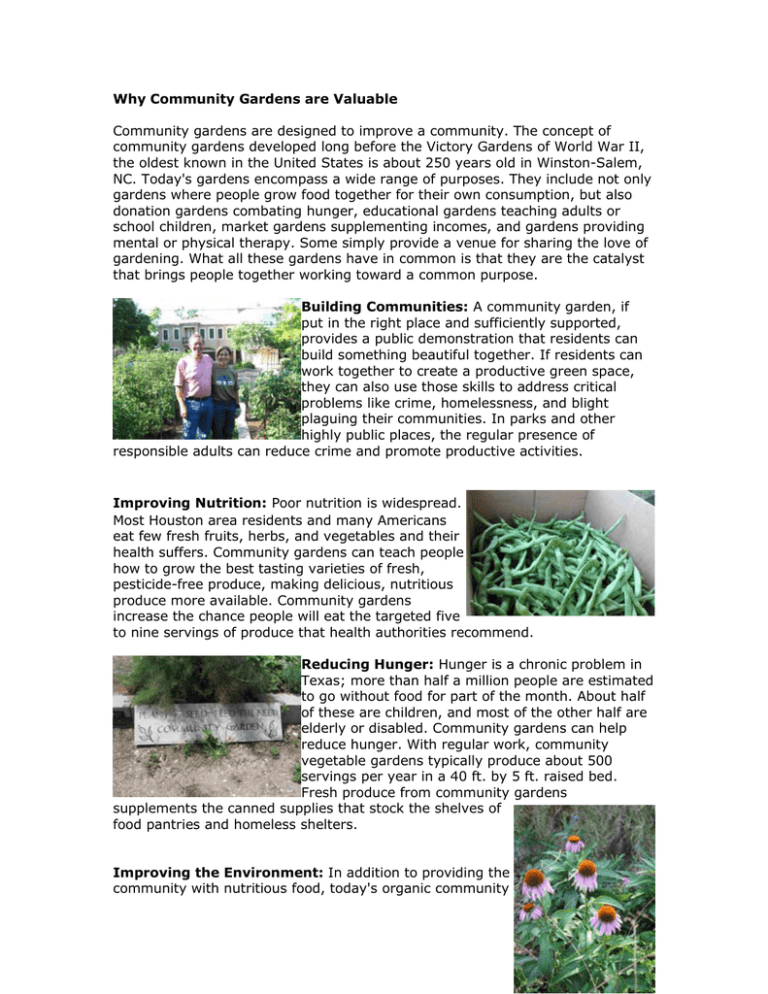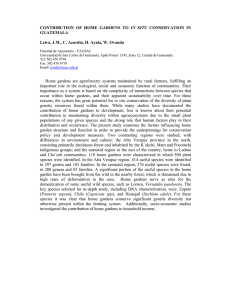Why Community Gardens are Valuable
advertisement

Why Community Gardens are Valuable Community gardens are designed to improve a community. The concept of community gardens developed long before the Victory Gardens of World War II, the oldest known in the United States is about 250 years old in Winston-Salem, NC. Today's gardens encompass a wide range of purposes. They include not only gardens where people grow food together for their own consumption, but also donation gardens combating hunger, educational gardens teaching adults or school children, market gardens supplementing incomes, and gardens providing mental or physical therapy. Some simply provide a venue for sharing the love of gardening. What all these gardens have in common is that they are the catalyst that brings people together working toward a common purpose. Building Communities: A community garden, if put in the right place and sufficiently supported, provides a public demonstration that residents can build something beautiful together. If residents can work together to create a productive green space, they can also use those skills to address critical problems like crime, homelessness, and blight plaguing their communities. In parks and other highly public places, the regular presence of responsible adults can reduce crime and promote productive activities. Improving Nutrition: Poor nutrition is widespread. Most Houston area residents and many Americans eat few fresh fruits, herbs, and vegetables and their health suffers. Community gardens can teach people how to grow the best tasting varieties of fresh, pesticide-free produce, making delicious, nutritious produce more available. Community gardens increase the chance people will eat the targeted five to nine servings of produce that health authorities recommend. Reducing Hunger: Hunger is a chronic problem in Texas; more than half a million people are estimated to go without food for part of the month. About half of these are children, and most of the other half are elderly or disabled. Community gardens can help reduce hunger. With regular work, community vegetable gardens typically produce about 500 servings per year in a 40 ft. by 5 ft. raised bed. Fresh produce from community gardens supplements the canned supplies that stock the shelves of food pantries and homeless shelters. Improving the Environment: In addition to providing the community with nutritious food, today's organic community gardens teach and inspire sustainable land use. As our population continues to move from rural areas to urban centers, most of our agrarian heritage has been left behind or forgotten. Now we have no system in place for teaching or experiencing wise management and use of the land we have around us. In most Texas cities pests are too many; water bills are too high; and beneficial creatures are too few. Most people do not know how to control pests, irrigate the land or improve the soil in an environmentally friendly way. The soils are poor, yet, regrettably, organic wastes go to landfills. Community Gardens can teach sound land management and make ventures into food production successful. School gardens that complement and enhance classroom curricula can also serve as valuable demonstration gardens for the surrounding community. Providing Income: Despite Houston's 12 month growing season for nearly all vegetables and fruits, it may be the only very large city in the nation without a significant fresh produce industry. Other Texas cities have large numbers of unemployed people, vast amounts of unused land, yet few truck farmers. Community gardens can help deal with these problems. They can help gardeners learn how to grow food organically with a minimum of effort, and how to sell their crops to neighbors, local restaurants, and caterers who are desperately searching for sources of locally grown, good tasting produce. Subscription gardening, ongoing contract sales to a group of people, also known as CSA (community supported agriculture), and Green Markets (small scale, periodic markets with sales of produce by the grower) are other marketing options for gardeners who have smaller quantities of produce to sell. Improving Physical and Mental Health: Health, physical exercise or therapy are other possible aims of community gardens. Taking care of plants, watching birds and butterflies, enjoying the outdoors and getting exercise are all good for body and spirit. Community gardens can help people suffering from stress and many forms of mental and physical illness.





